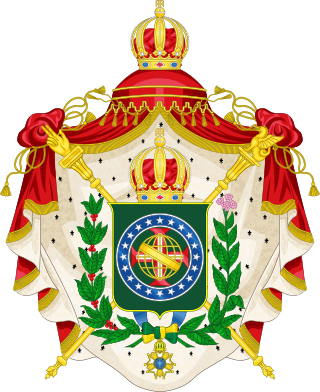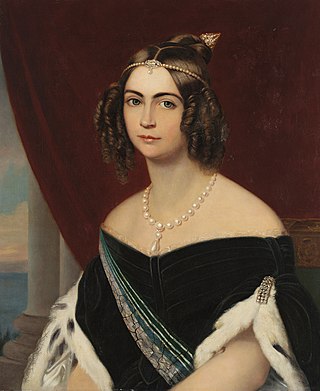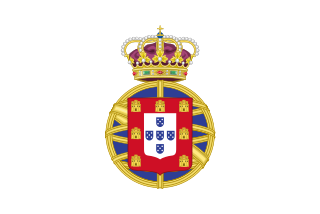Contents
| 1826 in Brazil |
|---|
| Flag |
 19 stars (1823–70) |
| Timeline of Brazilian history |
| Empire of Brazil |
| Year of Constitution: 1824 |
Events in the year 1826 in Brazil .
| 1826 in Brazil |
|---|
| Flag |
 19 stars (1823–70) |
| Timeline of Brazilian history |
| Empire of Brazil |
| Year of Constitution: 1824 |
Events in the year 1826 in Brazil .

DomPedro I was the founder and first ruler of the Empire of Brazil, where he was known as "the Liberator". As King Dom Pedro IV, he reigned briefly over Portugal, where he also became known as "the Liberator" as well as "the Soldier King". Born in Lisbon, Pedro I was the fourth child of King Dom John VI of Portugal and Queen Carlota Joaquina, and thus a member of the House of Braganza. When the country was invaded by French troops in 1807, he and his family fled to Portugal's largest and wealthiest colony, Brazil.

The Liberal Wars, also known as the War of the Two Brothers, was a war between liberal constitutionalists and conservative traditionalists in Portugal over royal succession that lasted from 1828 to 1834. Embroiled parties included the Kingdom of Portugal, Portuguese rebels, the United Kingdom, France, the Catholic Church, and Spain.

Dona Maria II "the Educator" or "the Good Mother", was Queen of Portugal from 1826 to 1828, and again from 1834 to 1853. Her supporters considered her to be the rightful queen also during the period between her two reigns.

The Most Serene House of Braganza, also known as the Brigantine dynasty, is a dynasty of emperors, kings, princes, and dukes of Portuguese origin which reigned in Europe and the Americas.

Dona Maria Leopoldina of Austria was the first Empress of Brazil as the wife of Emperor Dom Pedro I from 12 October 1822 until her death. She was also Queen of Portugal during her husband's brief reign as King Dom Pedro IV from 10 March to 2 May 1826.

Domitilade Castro do Canto e Melo, 1st Viscountess with designation as a Grandee, then 1st Marchioness of Santos, was a Brazilian noblewoman and the long-term mistress and favorite of Emperor Pedro I.

The Imperial House of Brazil is a Brazilian dynasty of Portuguese origin that ruled the Brazilian Empire from 1822 to 1889, from the time when the then Prince Royal Dom Pedro of Braganza declared Brazil's independence, until Dom Pedro II was deposed during the military coup that led to the Proclamation of the Republic in 1889.

Infanta Isabel Maria of Braganza was a Portuguese infanta (princess) and fourth daughter of King John VI of Portugal and his wife Carlota Joaquina of Spain. She acted as regent for her brother Pedro IV and for her niece Maria II in 1826-1828.

Amélie of Leuchtenberg was Empress of Brazil as the wife of Pedro I of Brazil.

The Battle of Ituzaingó, also known as the Battle of Passo do Rosário, was a pitched battle fought in the vicinity of the Santa Maria River, in a valley of small hills where a stream divided the valley into two.

The United Kingdom of Portugal, Brazil and the Algarves was a pluricontinental monarchy formed by the elevation of the Portuguese colony named State of Brazil to the status of a kingdom and by the simultaneous union of that Kingdom of Brazil with the Kingdom of Portugal and the Kingdom of the Algarves, constituting a single state consisting of three kingdoms.

The House of Orléans-Braganza is by legitimacy, the imperial house of Brazil formed in 1864, with the marriage of the heir to the Brazilian throne, Isabel of Braganza with Prince Gaston, Count of Eu. The House of Orléans-Braganza never reigned, as Brazil's pure Braganza monarch, Emperor Pedro II being deposed in a military coup d'état, under the pressure of the civilian republicans, in 1889. However, with the death of Isabel in 1921, as the last Brazilian pure Braganza, her descendants inherited the dynastic rights of the Brigantine dynasty over the defunct Brazilian throne.

Dona Paula was a princess of the Empire of Brazil and thus, a member of the Brazilian branch of the Portuguese House of Braganza. Her parents were Emperor Dom Pedro I, the first ruler of an independent Brazil, and Archduchess Leopoldina of Austria. Born in Rio de Janeiro, Paula was the couple's fifth child and third daughter child; she lost her mother at the age of three and her father at the age of eight, when he abdicated and left Brazil for Portugal, where he wanted to restore the throne of Paula's eldest sister, Maria da Glória, who should have become queen regnant of Portugal.

Dona Maria Amélia was a princess of the Empire of Brazil and a member of the Brazilian branch of the House of Braganza. Her parents were Emperor Dom Pedro I, the first ruler of Brazil, and Amélie of Leuchtenberg. The only child of her father's second marriage, Maria Amélia was born in France after Pedro I abdicated the Brazilian throne in favor of his son Dom Pedro II. Before Maria Amélia was a month old, Pedro I went to Portugal to restore the crown of the eldest daughter of his first marriage, Dona Maria II. He fought a successful war against his brother Miguel I, who had usurped Maria II's throne.

The Ipiranga Brook, is a river of São Paulo state in southeastern Brazil, historically known as the place where Dom Pedro I declared the independence of Brazil from the United Kingdom of Portugal, Brazil and the Algarves.

The Pantheon of the House of Braganza, also known as the Pantheon of the Braganzas, is the final resting place for many of the members of the House of Braganza, located in the Monastery of São Vicente de Fora in the Alfama district of Lisbon, Portugal. The pantheon's burials have included Portuguese monarchs, Brazilian monarchs, a Romanian monarch, queen consorts of Portugal, and notable Infantes of Portugal, among others.

Diogo Antônio Feijó was a Brazilian politician and Catholic priest. He was the regent of the Empire of Brazil from October 1835 to September 1837. Aside from members of the Imperial family, he was the first to ever hold this position alone; the other was his appointed successor after his resignation, the Marquis of Olinda. Both were regents at the time Emperor Pedro II was still a minor.

The Monument to the Independence of Brazil is a granite and bronze monument located in the Independence Park in São Paulo, Brazil. It is also known as the Ipiranga Monument or the Altar of the Fatherland. The monument is located on the banks of the Ipiranga Brook, on the historic site where prince regent Pedro proclaimed the independence of the country on 7 September 1822.

Isabel Maria de Alcântara, 1st and only Duchess of Goiás, was a Brazilian noble, the recognized daughter, born out of wedlock, of Emperor Pedro I of Brazil and Domitila de Castro, Marchioness of Santos, having been baptized on 31 May 1824.

Diplomatic relations exist between the Republic of Austria and the Federative Republic of Brazil. Both nations are members of the United Nations.